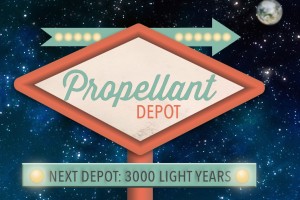A top-notch team of MIT engineers has scoped out orbiting way stations – one such depot placed somewhere between
the Earth and the Moon.
Once in place, this type of filling station could reduce the fuel a spacecraft needs to carry from Earth.
That means, with less fuel onboard, a rocket could launch heavier payloads, such as large scientific experiments.
The MIT team proposes using contingency propellant from past missions to fuel future spacecraft.
For instance, as a mission heads back to Earth, it may drop a tank of contingency propellant at a depot
before heading home. The next mission can pick up the fuel tank on its way to the Moon as its own emergency supply.
If it ends up not needing the extra propellant, it can also drop it at the depot for the next mission — an arrangement that the team refers to as a “steady-state” approach.
Study team
Leading the study is former astronaut, Jeffrey Hoffman, a professor in MIT’s Department of Aeronautics and Astronautics.
Hoffman and his students — Koki Ho, Katherine Gerhard, Austin Nicholas, and Alexander Buck – have outlined their depot architecture in the journal Acta Astronautica.
A depot may also accumulate contingency propellant from multiple missions, part of an approach the researchers call “stockpiling.”
Lagrange points
In the MIT study, spacecraft heading to the Moon would carry contingency propellant as they normally would, dropping the tank at a depot on the way back to Earth if it’s not needed; over time, the depot builds up a large fuel supply.
This way, if a large lunar mission launches in the future, its rocket wouldn’t need a huge fuel supply to launch the heavier payload. Instead, it can stop at the depot to collect the stockpiled propellant to fuel its landing on the Moon.
The MIT team came up with two depot designs to improve the efficiency of the basic scenario, according to an MIT press statement.
In both designs, depots would be stationed at Lagrange points — regions in space between the Earth, Moon, and Sun that maintain gravitational equilibrium. Objects at these points remain in place, keeping the same relative position with respect to the Earth and the Moon.
By Leonard David

